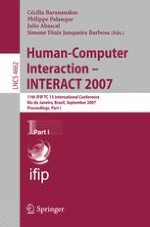2007 | Buch
Human-Computer Interaction – INTERACT 2007
11th IFIP TC 13 International Conference, Rio de Janeiro, Brazil, September 10-14, 2007, Proceedings, Part I
herausgegeben von: Cécilia Baranauskas, Philippe Palanque, Julio Abascal, Simone Diniz Junqueira Barbosa
Verlag: Springer Berlin Heidelberg
Buchreihe : Lecture Notes in Computer Science
